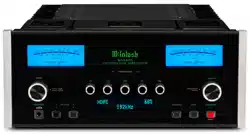Loading ...
Loading ...
Loading ...

16
Getting the Most Out of Your MA8950
Using the Autoformer:
Your MA8950 comes equipped with independent
connectors specifically allocated for loudspeakers
of 2-, 4-, and 8-ohm impedance. Separating these
connections allows McIntosh to use its patented
Autoformer to provide the full 200 watts of power
regardless of your speakers’ specifications.
Using the Five-Band Equalizer:
As with all McIntosh products, your MA8950
produces the clearest, most accurate form possible
of any audio that pumps through it. If the audio sent
from the source is suboptimal, however, then the
“clearest, most accurate form” might not be ideal for
every situation. If you find yourself wanting to adjust
the audio frequencies, enable the Equalizer (with the
button on the front panel or in the Trim Functions
Menu) to activate the functionality of the five
Frequency Adjustment Knobs. Turning the knobs will
adjust from the low frequencies (30Hz) up to the high
frequencies (10,000Hz). Experiment with different
rotations of the knobs to produce your desired sound.
The Equalizer will affect the sound for any Input that
has it on, and its On/Off status will be saved per Input.
Using Bi-Amplification on Loudspeakers:
WA R NI NG: If the loudspeakers you are attempting
to connect for bi-amplification have Jumper
Plugs connecting the mid/high and low frequen-
cies, they must be removed before making the
connections to the amplifier(s). Failure to do so
may result in damage to your equipment.
The MA8950’s onboard power amplifier may be used
in conjunction with a separate external power ampli-
fier to connect a loudspeaker for bi-amplification,
allowing more flexible power control to the separate
mid/high and low frequencies of the loudspeaker. You
will do this by first removing the McIntosh Jumper
Plugs from the Output 1 ports and the PWR AMP
ports on the MA8950. In their place, bridge each of
the left and right channels of the Output 1 and PWR
AMP ports with a shielded RCA Y splitter. Connect
the open ends of each of the Y splitters to your
separate external power amplifier.
Using the HXD with Headphones:
Enable Headphone Crossfeed Director (HXD) to
improve the sound localization for your headphones.
HXD restores the directionality component of the
spatial sound stage, giving you the quality and
immersion of a loudspeaker paired with the privacy of
headphones.
Listening Worry-Free (Auto Protection):
The internal McIntosh Power Guard monitors and
adjusts sound waves at the speed of light, preventing
harsh sounding distortion and clipping that could
damage your speakers. The Power Guard LED lights
on the front panel will be lit when it automatically
activates. The MA8950 also includes an internal
Sentry Monitor, which guages the amount of incoming
electricity and will automatically protect your unit in
the event of improper current flow, allowing you to
listen while knowing your unit is safe.
Using the Onboard Power Amplifier:
To use the internal preamplifier and power amplifier
simultaneously, connect the Output 1 ports and the
PWR AMP ports using the included Jumper Plugs.
This audio will be produced through Output 1.
Using External Power Amplifiers:
While your MA8950 comes fully equipped with a
preamplifier and a power amplifier with the capability
of playing the crystal-clear audio you'd expect from
McIntosh amps through your loudspeakers, you have
the option to attach separate power amplifiers if you
so choose. You can do this while using the onboard
power amplifier, or you can disable the onboard power
amplifier and only use separate ones.
Using MA8950 with External Amp:
Connect your loudspeakers to the MA8950 and use
the Output 2 ports to send a signal to an external
amplifier, leaving the McIntosh Jumper Plugs that are
bridging the Output 1 ports and the PWR AMP ports
right where they are.
Using Only External Amps:
To disable the functionality of the onboard power
amplifier, disconnect any loudspeakers from the
MA8950 and remove the McIntosh Jumper Plugs
bridging the Output 1 ports and the PWR AMP ports.
This will turn your MA8950 into a dedicated pream-
plifier, allowing you to send signals from Output 1 and
Output 2 to external power amplifiers.
Using Audio Passthru:
When using the MA8950 as part of a home theater
system, you will likely want to enable audio Passthru
to ensure proper flexibility with your audio signals.
To do this, connect a cable from one of your A/V
processor’s trigger ports to the MA8950’s Passthru
Input port. Then, connect left and right audio signals
from the A/V processor to a left and right Input port,
respectively, on the MA8950. Finally, enable that Input
for Passthru in the Setup Menu (see Page 14).
Viewing Coax/Optical Inputs Sample Rate:
When coaxial or optical inputs are selected and
producing a signal, the Display will show the sample
rate of the signal under the input name. If no signal
is being received through the inputs, the Display will
show a dotted line under the input name.
Using USB Playback:
You can play audio from your computer through
the MA8950 while it’s connected via USB. You can
see the sample rate of the playback on the second
line of the Display while the USB Input is selected.
The sample rate is affected by the audio source, the
software used for playback, and the Settings set in the
McIntosh HD Control Panel software.
Loading ...
Loading ...
Loading ...
